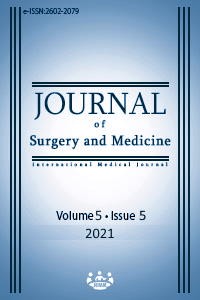Comparison of conventional surgical method and eversion technique in carotid endarterectomy operations
Keywords:
Carotid stenosis, Eversion carotid endarterectomy, Conventional carotid endarterectomyAbstract
Background/Aim: Carotid endarterectomy is a highly effective and safe operation for preventing the risk of stroke in patients with symptomatic internal carotid artery stenosis. Several surgical techniques were described and available: Conventional carotid endarterectomy (CCEA) and eversion carotid endarterectomy (ECEA) are the two most common. Superiority of these two techniques to one another has not yet been clearly demonstrated. We aim to demonstrate the surgical and clinical experience of our institution regarding these two approaches. Methods: In this retrospective cohort study, forty-three consecutive patients operated for symptomatic carotid stenosis were divided into two groups according to the preferred surgical method (CCEA and ECEA), and compared in terms of postoperative hospital stay, use of shunts and antibiotics, early (30-day) complications, long-term restenosis, and mortality rates. Results: Demographic data and preoperative stenosis rates were similar between the two groups (P>0.05). In the CCEA group, subjects had a significantly longer clamping time (19.3 (4.1) vs 15.4 (3.4) min., P=0.002) and significant differences were found between operative time (35.1 (3.2) vs 28.7 (4.3) min) and need for shunting (25.7% vs 2.1%, P<0.001). CCEA patients had a higher percentage of antibiotic use (49.8% vs. 31.1%, P=0.04). Hematoma rates, complications during follow up, including stroke, heart attack, and mortality rate were similar between the groups, along with re-stenosis (P=0.754) and survival rates (P=0.241), according to Kaplan-Meier analysis. Conclusions: Our results showed that ECEA was a convenient surgical technique and more advantageous compared to CCEA with respect to early and long term follow up results. ECEA can be performed within a significantly shorter operative time and may decrease the necessity for shunting, although it may require specific experience.
Downloads
References
The top 10 causes of death n.d. https://www.who.int/news-room/fact-sheets/detail/the-top-10-causes-of-death (accessed March 9, 2021).
Flaherty ML, Kissela B, Khoury JC, Alwell K, Moomaw CJ, Woo D, et al. Carotid artery stenosis as a cause of stroke. Neuroepidemiology 2012; 40:36–41. doi: 10.1159/000341410.
Eckstein HH. European Society for Vascular Surgery Guidelines on the Management of Atherosclerotic Carotid and Vertebral Artery Disease. European Journal of Vascular and Endovascular Surgery 2018; 55:1–2. doi: 10.1016/j.ejvs.2017.06.026.
Mas JL, Trinquart L, Leys D, Albucher JF, Rousseau H, Viguier A, et al. Endarterectomy Versus Angioplasty in Patients with Symptomatic Severe Carotid Stenosis (EVA-3S) trial: results up to 4 years from a randomised, multicentre trial. The Lancet Neurology 2008; 7:885–92. doi: 10.1016/S1474-4422(08)70195-9.
de Bakey ME, Crawford ES, Cooley DA, Morris GC. Surgical considerations of occlusive disease of innominate, carotid, subclavian, and vertebral arteries. Annals of Surgery 1959; 149:690–710. doi: 10.1097/00000658-195905000-00010.
Cao P, de Rango P, Zannetti S, Giordano G, Ricci S, Celani MG. Eversion versus conventional carotid endarterectomy for preventing stroke. Cochrane Database of Systematic Reviews 2000. doi: 10.1002/14651858.cd001921.
Bond R, Rerkasem K, Naylor AR, Aburahma AF, Rothwell PM. Systematic review of randomized controlled trials of patch angioplasty versus primary closure and different types of patch materials during carotid endarterectomy. Journal of Vascular Surgery 2004; 40:1126–35. doi: 10.1016/j.jvs.2004.08.048.
Dakour-Aridi H, Ou M, Locham S, AbuRahma A, Schneider JR, Malas M. Outcomes following Eversion versus Conventional Endarterectomy in the Vascular Quality Initiative Database. Annals of Vascular Surgery, vol. 65, Elsevier Inc.; 2020, p. 1–9. doi: 10.1016/j.avsg.2019.07.021.
Katras T, Baltazar U, Rush DS, Sutterfield WC, Harvill LM, Stanton PE. Durability of eversion carotid endarterectomy: Comparison with primary closure and carotid patch angioplasty. Journal of Vascular Surgery 2001; 34:453–8. doi: 10.1067/mva.2001.117885.
Stone PA, Srivastava M, Campbell JE, Mousa AY, Hass SH, Kazmi H, et al. A 10-year experience of infection following carotid endarterectomy with patch angioplasty. Journal of Vascular Surgery 2011; 53:1473–7. doi: 10.1016/j.jvs.2011.02.020.
Mann CD, McCarthy M, Nasim A, Bown M, Dennis M, Sayers R, et al. Management and outcome of prosthetic patch infection after carotid endarterectomy: A single-centre series and systematic review of the literature. European Journal of Vascular and Endovascular Surgery 2012; 44:20–6. doi: 10.1016/j.ejvs.2012.04.025.
Jamil M, Usman R, Ghaffar S. Advantages of Selective Use of Intraluminal Shunt in Carotid Endarterectomy: A Study of 122 Cases. JstageJstGoJp n.d. doi: 10.3400/avd.oa.16-00036.
Woodworth GF, McGirt MJ, Than KD, Huang J, Perler BA, Tamargo RJ. Selective versus routine intraoperative shunting during carotid endarterectomy: A multivariate outcome analysis. Neurosurgery 2007; 61:1170–6. doi: 10.1227/01.neu.0000306094.15270.40.
AbuRahma AF, Mousa AY, Stone PA. Shunting during carotid endarterectomy. Journal of Vascular Surgery 2011; 54:1502–10. doi: 10.1016/j.jvs.2011.06.020.
Archie JP. A fifteen-year experience with carotid endarterectomy after a formal operative protocol requiring highly frequent patch angioplasty. Journal of Vascular Surgery 2000; 31:724–35. doi: 10.1067/mva.2000.104591.
Downloads
- 303 461
Published
Issue
Section
How to Cite
License
Copyright (c) 2021 Hacı Ali Uçak, İbrahim Özsöyler
This work is licensed under a Creative Commons Attribution-NonCommercial-NoDerivatives 4.0 International License.
















